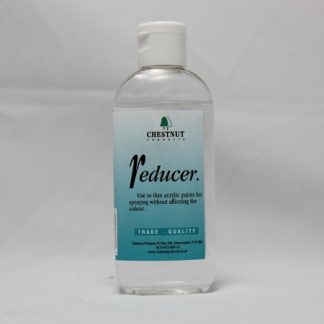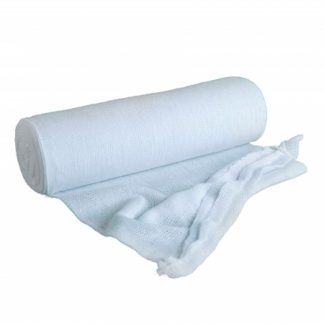 Ebonising Lacquer is a tough, hard-wearing water-based lacquer. It is heavily pigmented so that when it is dry it emulates the classic satin look of ebony.
Usually applied over a sanding sealer (either Cellulose Sanding Sealer or Acrylic Sanding Sealer aerosol) it is touch dry in about five minutes and hard dry after twenty minutes.
Although heavily pigmented it is not paint and will still allow the grain of the timber to show through, rather than obliterating it completely.
Liming Wax and Gilt Cream can be applied over Ebonising Lacquer to give a pleasing, eye-catching yet very simple artistic effect.
If a bright gloss finish is required from Ebonising Lacquer this is best achieved by using Burnishing Cream on the lacquer with will polish it up to a high gloss.
Acrylic Gloss Lacquer can also be applied on top of Ebonising Lacquer, as can WoodWax 22 and Microcrystalline Wax.
Ebonising Lacquer is a tough, hard-wearing water-based lacquer. It is heavily pigmented so that when it is dry it emulates the classic satin look of ebony.
Usually applied over a sanding sealer (either Cellulose Sanding Sealer or Acrylic Sanding Sealer aerosol) it is touch dry in about five minutes and hard dry after twenty minutes.
Although heavily pigmented it is not paint and will still allow the grain of the timber to show through, rather than obliterating it completely.
Liming Wax and Gilt Cream can be applied over Ebonising Lacquer to give a pleasing, eye-catching yet very simple artistic effect.
If a bright gloss finish is required from Ebonising Lacquer this is best achieved by using Burnishing Cream on the lacquer with will polish it up to a high gloss.
Acrylic Gloss Lacquer can also be applied on top of Ebonising Lacquer, as can WoodWax 22 and Microcrystalline Wax.
-

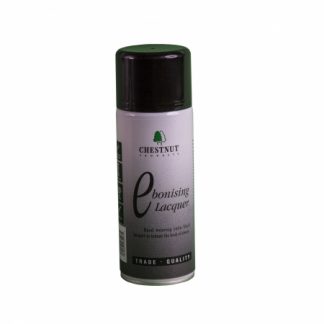
 Ebonising Lacquer is a tough, hard-wearing water-based lacquer. It is heavily pigmented so that when it is dry it emulates the classic satin look of ebony.
Usually applied over a sanding sealer (either Cellulose Sanding Sealer or Acrylic Sanding Sealer aerosol) it is touch dry in about five minutes and hard dry after twenty minutes.
Although heavily pigmented it is not paint and will still allow the grain of the timber to show through, rather than obliterating it completely.
Liming Wax and Gilt Cream can be applied over Ebonising Lacquer to give a pleasing, eye-catching yet very simple artistic effect.
If a bright gloss finish is required from Ebonising Lacquer this is best achieved by using Burnishing Cream on the lacquer with will polish it up to a high gloss.
Acrylic Gloss Lacquer can also be applied on top of Ebonising Lacquer, as can WoodWax 22 and Microcrystalline Wax.
Ebonising Lacquer is a tough, hard-wearing water-based lacquer. It is heavily pigmented so that when it is dry it emulates the classic satin look of ebony.
Usually applied over a sanding sealer (either Cellulose Sanding Sealer or Acrylic Sanding Sealer aerosol) it is touch dry in about five minutes and hard dry after twenty minutes.
Although heavily pigmented it is not paint and will still allow the grain of the timber to show through, rather than obliterating it completely.
Liming Wax and Gilt Cream can be applied over Ebonising Lacquer to give a pleasing, eye-catching yet very simple artistic effect.
If a bright gloss finish is required from Ebonising Lacquer this is best achieved by using Burnishing Cream on the lacquer with will polish it up to a high gloss.
Acrylic Gloss Lacquer can also be applied on top of Ebonising Lacquer, as can WoodWax 22 and Microcrystalline Wax.

-
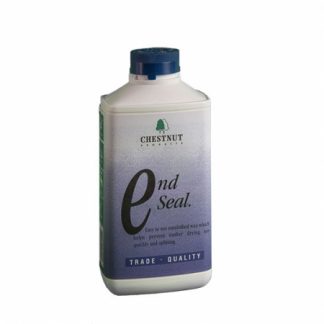 End Seal is an emulsified paraffin wax used the seal the ends of freshly cut timber to slow down the drying process and reduce the risk of the timber splitting. It can also be used on work-in-progress that is being left unfinished where there is a risk of the timber splitting. Apply it liberally, normally by brush but it can be sprayed if needed, usually to the smallest surface of the timber which will normally be the end grain where moisture is most likely to escape from. Sealing the surface will encourage the moisture to escape via the larger areas which will result in a slower exit.
End Seal is an emulsified paraffin wax used the seal the ends of freshly cut timber to slow down the drying process and reduce the risk of the timber splitting. It can also be used on work-in-progress that is being left unfinished where there is a risk of the timber splitting. Apply it liberally, normally by brush but it can be sprayed if needed, usually to the smallest surface of the timber which will normally be the end grain where moisture is most likely to escape from. Sealing the surface will encourage the moisture to escape via the larger areas which will result in a slower exit. -

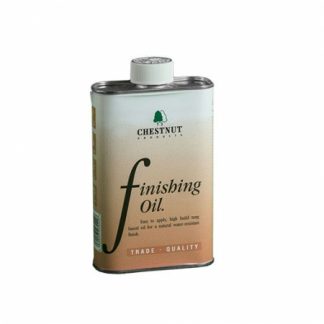
 Chestnut Finishing Oil is Chestnuts' version of Danish Oil* and uses Tung Oil as its base but with the addition of solvents and driers. This aids the drying of the product and speeds it up dramatically, so that it’s dry within eight hours. It has a pale amber colour and dries to a hard yet flexible film which is very hardwearing and water resistant.
For a high gloss finish apply several coats with a light rub down between coats; after 5 or 6 coats a good sheen should be visible.
Finishing Oil is normally applied by cloth but on larger areas a brush can be used very successfully.
Chestnut Finishing Oil is Chestnuts' version of Danish Oil* and uses Tung Oil as its base but with the addition of solvents and driers. This aids the drying of the product and speeds it up dramatically, so that it’s dry within eight hours. It has a pale amber colour and dries to a hard yet flexible film which is very hardwearing and water resistant.
For a high gloss finish apply several coats with a light rub down between coats; after 5 or 6 coats a good sheen should be visible.
Finishing Oil is normally applied by cloth but on larger areas a brush can be used very successfully.

-
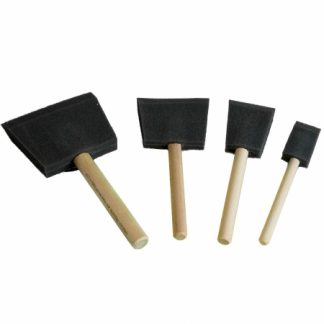 Made in the USA, these are the original and best quality Foam Brush. Manufactured using a special foam with a stiffener inside to make sure they keep their shape in use, and supplied with a solid wooden handle attached. Great for eliminating brush marks (no bristles = no brush marks) and there’s no danger of any stray bristles coming loose and spoiling your work. Priced to be semi-disposable they will normally wash out several times for re-use. Fantastic for applying acrylic finishes which have a tendency to froth up when applied by brush – the Foam Brush virtually eliminates this completely. Can also be used for painting, particularly gloss paints, seasoned users have been known to have a brush in each hand!
Made in the USA, these are the original and best quality Foam Brush. Manufactured using a special foam with a stiffener inside to make sure they keep their shape in use, and supplied with a solid wooden handle attached. Great for eliminating brush marks (no bristles = no brush marks) and there’s no danger of any stray bristles coming loose and spoiling your work. Priced to be semi-disposable they will normally wash out several times for re-use. Fantastic for applying acrylic finishes which have a tendency to froth up when applied by brush – the Foam Brush virtually eliminates this completely. Can also be used for painting, particularly gloss paints, seasoned users have been known to have a brush in each hand! -

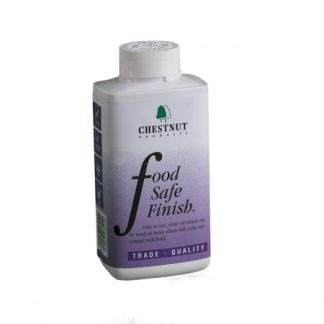 Food Safe Finish is a clear, food grade mineral oil. Chestnut use a thin grade of oil to allow it to soak into bare timber which then protects it against water splashes etc whilst not tainting or affecting the food in any way. It dries to a fairly matt finish; it is however ideal to use for wet sanding and when used with a very fine abrasive it can give an exceptionally smooth surface which has its own gentle glow. Apply with a clean cloth or brush direct onto bare wood, up to three coats are recommended. If the oil sits on the surface and won’t soak in it means the timber has absorbed as much as it can and no further coats are needed. Any surplus can be removed with a clean cloth if required. Depending on the way the item is used it might be necessary to top-up the finish, especially if it is washed regularly.
Food Safe Finish is a clear, food grade mineral oil. Chestnut use a thin grade of oil to allow it to soak into bare timber which then protects it against water splashes etc whilst not tainting or affecting the food in any way. It dries to a fairly matt finish; it is however ideal to use for wet sanding and when used with a very fine abrasive it can give an exceptionally smooth surface which has its own gentle glow. Apply with a clean cloth or brush direct onto bare wood, up to three coats are recommended. If the oil sits on the surface and won’t soak in it means the timber has absorbed as much as it can and no further coats are needed. Any surplus can be removed with a clean cloth if required. Depending on the way the item is used it might be necessary to top-up the finish, especially if it is washed regularly.
-

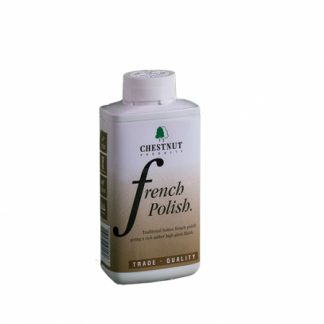 Confusingly, French Polish refers to a range of polishes (which would include Button Polish, White Polish, Garnet Polish etc) and also to a specific polish, French Polish. Chestnuts' French Polish is a traditional blend of solvent (methylated spirit) and a top quality unbleached shellac which is very similar to a Button Polish in colour. Applied either to bare timber or over a Shellac Sanding Sealer it is built up in many layers which have been described as being the thickness of a cigarette paper! French Polish gives the rich amber glow found on fine antique furniture and requires a very specific technique for application that is time consuming and laborious, but the final effect has to be seen to be believed and the satisfaction of achieving it is its own reward. A French Polish finish is not very hard wearing and is recommended for items that are going to be cared for.
Confusingly, French Polish refers to a range of polishes (which would include Button Polish, White Polish, Garnet Polish etc) and also to a specific polish, French Polish. Chestnuts' French Polish is a traditional blend of solvent (methylated spirit) and a top quality unbleached shellac which is very similar to a Button Polish in colour. Applied either to bare timber or over a Shellac Sanding Sealer it is built up in many layers which have been described as being the thickness of a cigarette paper! French Polish gives the rich amber glow found on fine antique furniture and requires a very specific technique for application that is time consuming and laborious, but the final effect has to be seen to be believed and the satisfaction of achieving it is its own reward. A French Polish finish is not very hard wearing and is recommended for items that are going to be cared for.
-

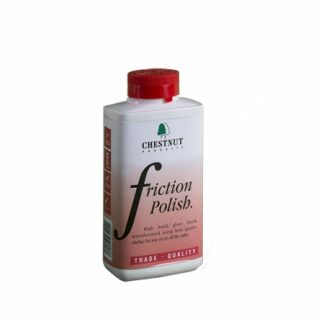 Friction Polish is a shellac based polish ideal for creating a high gloss finish on or off the lathe. It’s a great decorative finish and is ideal for small items but can be difficult to apply to larger items on the lathe (over about 8 inch diameter). The high amount of shellac in Friction Polish does two main things. Firstly it helps seal bare wood and give it a great shine, which is good. Sadly the price of this commodity shot up a few years ago when the shellac crop failed and it never went back down, meaning that the cost of the polish has also risen sharply. Nevertheless, Friction Polish remains one of the most popular finishes for turners. It can be applied to bare wood but is normally used over a sealer and any of the sealers in the Chestnut Products range are suitable for this. Applied with the lathe running it dries almost instantly and builds to a deep, rich shine very quickly. Avoid using too much as this can cause ‘rings’ to appear on the surface. Friction Polish can be applied off the lathe with great success, using it like a French Polish and rubbing it into the surface. This does require a large amount of elbow grease (sadly not something we supply) but the end result is well worth the effort!
Friction Polish is a shellac based polish ideal for creating a high gloss finish on or off the lathe. It’s a great decorative finish and is ideal for small items but can be difficult to apply to larger items on the lathe (over about 8 inch diameter). The high amount of shellac in Friction Polish does two main things. Firstly it helps seal bare wood and give it a great shine, which is good. Sadly the price of this commodity shot up a few years ago when the shellac crop failed and it never went back down, meaning that the cost of the polish has also risen sharply. Nevertheless, Friction Polish remains one of the most popular finishes for turners. It can be applied to bare wood but is normally used over a sealer and any of the sealers in the Chestnut Products range are suitable for this. Applied with the lathe running it dries almost instantly and builds to a deep, rich shine very quickly. Avoid using too much as this can cause ‘rings’ to appear on the surface. Friction Polish can be applied off the lathe with great success, using it like a French Polish and rubbing it into the surface. This does require a large amount of elbow grease (sadly not something we supply) but the end result is well worth the effort!
-

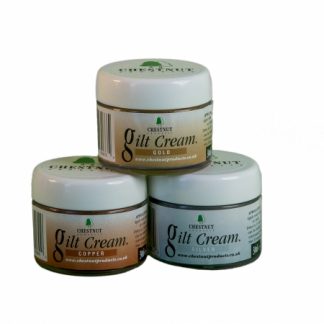 Gilt Creams are a creamy, waxy paste with metallic flakes and pigments in them, giving a rich, lustrous finish to whatever they are applied to. The can be used for a ‘limed’ effect over a lacquer to give a high contrast effect, or uniformly over a piece and polished to a bright shine once dried. Available in
Gilt Creams are a creamy, waxy paste with metallic flakes and pigments in them, giving a rich, lustrous finish to whatever they are applied to. The can be used for a ‘limed’ effect over a lacquer to give a high contrast effect, or uniformly over a piece and polished to a bright shine once dried. Available in- Gold
- Silver
- Copper

-

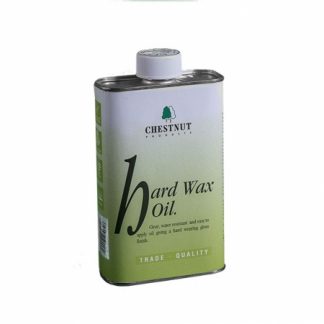
 If you’re looking for a clear finish that is tough, hardwearing and gives a bright gloss yet is still very easy to apply, even on larger areas, you’re in the right place.
Hard Wax Oil is a particular blend of tough oils combined with special waxes which dries to an exceptionally resilient finish. Ideal for anything that is going to be subjected to water splashes or a lot of handling this oil may not be indestructible but it will stand up to a lot of abuse.
It retains the ease of application typical of an oil and it stays wet long enough to get a smooth, even finish – even on large areas – but is touch dry and tack free in about 20 minutes, and better yet is ready for a second coat after about four hours (in normal conditions).
Hard Wax Oil will build to a bright gloss finish after 2-3 coats. Rub down lightly between coats with a fine abrasive. Once hard dry (allow at least 24 hours) it can be brought to an even brighter shine using either the buffing wheel system or burnishing cream.
For a not-quite-so-bright finish use a mild abrasive to reduce the gloss. For best results lubricate the abrasive with microcrystalline wax to retain the toughness of the oil.
If you’re looking for a clear finish that is tough, hardwearing and gives a bright gloss yet is still very easy to apply, even on larger areas, you’re in the right place.
Hard Wax Oil is a particular blend of tough oils combined with special waxes which dries to an exceptionally resilient finish. Ideal for anything that is going to be subjected to water splashes or a lot of handling this oil may not be indestructible but it will stand up to a lot of abuse.
It retains the ease of application typical of an oil and it stays wet long enough to get a smooth, even finish – even on large areas – but is touch dry and tack free in about 20 minutes, and better yet is ready for a second coat after about four hours (in normal conditions).
Hard Wax Oil will build to a bright gloss finish after 2-3 coats. Rub down lightly between coats with a fine abrasive. Once hard dry (allow at least 24 hours) it can be brought to an even brighter shine using either the buffing wheel system or burnishing cream.
For a not-quite-so-bright finish use a mild abrasive to reduce the gloss. For best results lubricate the abrasive with microcrystalline wax to retain the toughness of the oil.

-


 If you’re looking for a clear finish that is tough, hardwearing and gives a satin lustre yet is still very easy to apply, even on larger areas, you’re in the right place.
Hard Wax Oil is a particular blend of tough oils combined with special waxes which dries to an exceptionally resilient finish. Ideal for anything that is going to be subjected to water splashes or a lot of handling this oil may not be indestructible but it will stand up to a lot of abuse.
It retains the ease of application typical of an oil and it stays wet long enough to get a smooth, even finish – even on large areas – but is touch dry and tack free in about 20 minutes, and better yet is ready for a second coat after about four hours (in normal conditions).
Hard Wax Oil will build to a bright gloss finish after 2-3 coats. Rub down lightly between coats with a fine abrasive. Once hard dry (allow at least 24 hours) it can be brought to an even brighter shine using either the buffing wheel system or burnishing cream.
For a not-quite-so-bright finish use a mild abrasive to reduce the gloss. For best results lubricate the abrasive with microcrystalline wax to retain the toughness of the oil.
If you’re looking for a clear finish that is tough, hardwearing and gives a satin lustre yet is still very easy to apply, even on larger areas, you’re in the right place.
Hard Wax Oil is a particular blend of tough oils combined with special waxes which dries to an exceptionally resilient finish. Ideal for anything that is going to be subjected to water splashes or a lot of handling this oil may not be indestructible but it will stand up to a lot of abuse.
It retains the ease of application typical of an oil and it stays wet long enough to get a smooth, even finish – even on large areas – but is touch dry and tack free in about 20 minutes, and better yet is ready for a second coat after about four hours (in normal conditions).
Hard Wax Oil will build to a bright gloss finish after 2-3 coats. Rub down lightly between coats with a fine abrasive. Once hard dry (allow at least 24 hours) it can be brought to an even brighter shine using either the buffing wheel system or burnishing cream.
For a not-quite-so-bright finish use a mild abrasive to reduce the gloss. For best results lubricate the abrasive with microcrystalline wax to retain the toughness of the oil.

-
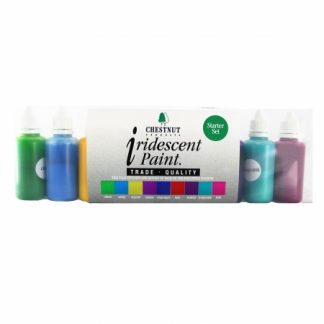 Iridescent Paints give a change in hue, a slight colour shift when viewed from different angles and are especially effective on irregularly shaped items.Available in nine different amazingly bright and vibrant colours –
Iridescent Paints give a change in hue, a slight colour shift when viewed from different angles and are especially effective on irregularly shaped items.Available in nine different amazingly bright and vibrant colours –- Green
- Azure
- Purple
- Red
- Turquoise
- Cerise
- Pink
- Yellow
- Vivid Blue
The paints are water based acrylics and can be applied by brush, cloth, spray gun/airbrush or any manner of ways to give interesting decorative effects. -
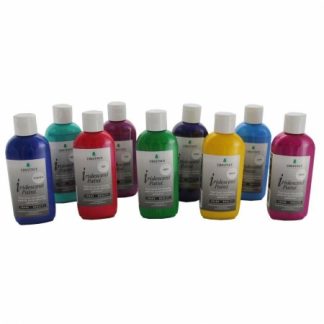 Iridescent Paints give a change in hue, a slight colour shift when viewed from different angles and are especially effective on irregularly shaped items.Available in nine different amazingly bright and vibrant colours –
Iridescent Paints give a change in hue, a slight colour shift when viewed from different angles and are especially effective on irregularly shaped items.Available in nine different amazingly bright and vibrant colours –- Green
- Azure
- Purple
- Red
- Turquoise
- Cerise
- Pink
- Yellow
- Vivid Blue
The paints are water based acrylics and can be applied by brush, cloth, spray gun/airbrush or any manner of ways to give interesting decorative effects. -

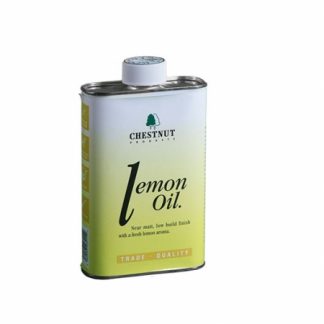 If you’re looking for a finish that won’t change the colour of your timber, won’t overpower the natural beauty of the wood with a high gloss but will still protect the timber and smell nice, well, you’re in the right place! Lemon Oil is a clear, low build finish. By that we mean that it’s a very thin liquid with a very low solids content, so no matter how much you apply it’s not going to build up to a discernible visible film on the surface. Instead it soaks in and seals the surface, offering a level of water resistance and protection against handling. Normally applied with a brush or a cloth it’s very easy to use and covers well and doesn’t usually show overlaps, so it’s ideal for large areas which often look better without a high gloss. And as you might expect, it has a pleasant lemon aroma too, although this does fade after a while.
If you’re looking for a finish that won’t change the colour of your timber, won’t overpower the natural beauty of the wood with a high gloss but will still protect the timber and smell nice, well, you’re in the right place! Lemon Oil is a clear, low build finish. By that we mean that it’s a very thin liquid with a very low solids content, so no matter how much you apply it’s not going to build up to a discernible visible film on the surface. Instead it soaks in and seals the surface, offering a level of water resistance and protection against handling. Normally applied with a brush or a cloth it’s very easy to use and covers well and doesn’t usually show overlaps, so it’s ideal for large areas which often look better without a high gloss. And as you might expect, it has a pleasant lemon aroma too, although this does fade after a while.
-

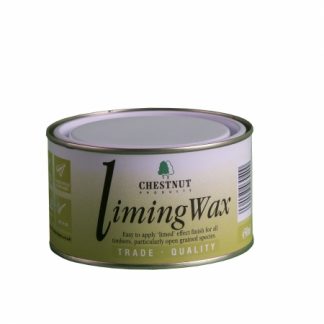 The white pigment in Liming Wax is Titanium Dioxide (TiO2) which gives it a brilliant white finish which will perfectly highlight open grain. Use Liming Wax on any open grained timber for a dramatic and striking effect which can be emphasised by using a stain or Ebonising Lacquer first. For an even better result use the Liming Brush first to open up the grain, allowing more Liming Wax to enter; spread the Liming Wax over the whole surface and then wipe off after a few minutes. The Liming Wax will stay in the open grain and the effect will be instantly visible. Whilst Liming Wax is a wax (obviously!), the wax is mainly a carrier for the white pigment. Therefore an overcoat of some kind is needed. WoodWax 22, Microcrystalline Wax, Finishing Oil or Hard Wax Oil are ideal for this and will lock the wax in place whilst keeping it clean and bright.
The white pigment in Liming Wax is Titanium Dioxide (TiO2) which gives it a brilliant white finish which will perfectly highlight open grain. Use Liming Wax on any open grained timber for a dramatic and striking effect which can be emphasised by using a stain or Ebonising Lacquer first. For an even better result use the Liming Brush first to open up the grain, allowing more Liming Wax to enter; spread the Liming Wax over the whole surface and then wipe off after a few minutes. The Liming Wax will stay in the open grain and the effect will be instantly visible. Whilst Liming Wax is a wax (obviously!), the wax is mainly a carrier for the white pigment. Therefore an overcoat of some kind is needed. WoodWax 22, Microcrystalline Wax, Finishing Oil or Hard Wax Oil are ideal for this and will lock the wax in place whilst keeping it clean and bright.
-
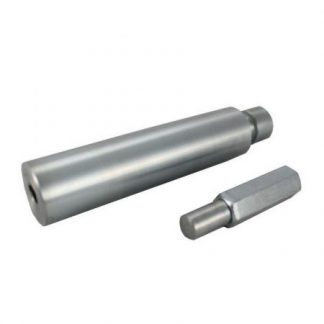 These Mandrels are available separately or come as part of the buffing wheel kit. Both Mandrels are made in the UK and are zinc plated for maximum protection. Due to the limitations of plating a blind hole care should be taken to ensure the tapped thread of the large mandrel stays as dry as possible. The large mandrel is designed to be held in a lathe chuck. It is 25mm in diameter at its widest part, stepped to 18mm with an undercut for smaller chucks. It can be held on either, both will still give plenty of clearance from the chuck. The small mandrel is designed to be held in a jacobs chuck or similar and is especially suited to use with the smaller 4 inch wheels and the Dome Buffs.
These Mandrels are available separately or come as part of the buffing wheel kit. Both Mandrels are made in the UK and are zinc plated for maximum protection. Due to the limitations of plating a blind hole care should be taken to ensure the tapped thread of the large mandrel stays as dry as possible. The large mandrel is designed to be held in a lathe chuck. It is 25mm in diameter at its widest part, stepped to 18mm with an undercut for smaller chucks. It can be held on either, both will still give plenty of clearance from the chuck. The small mandrel is designed to be held in a jacobs chuck or similar and is especially suited to use with the smaller 4 inch wheels and the Dome Buffs. -

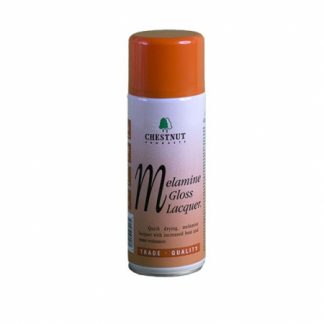
 Melamine Lacquer can be a bit fiddly to apply and there’s no better way than spraying it. If you don’t have access to spray equipment then this aerosol version is the ideal way.
Melamine Gloss Lacquer will quickly build to a bright gloss finish and dries in a matter of minutes.
Touch dry and safe to handle within five minutes the lacquer chemically cures to give a tougher finish. The lacquer achieves practically all of this (about 90%) within seven days, after which the process slows and can take up to another two weeks to fully complete.
Best used over a Cellulose Sanding Sealer (brushing or aerosol) and can be overcoated with a wax for a softer tactile feel.
Melamine Lacquer can be a bit fiddly to apply and there’s no better way than spraying it. If you don’t have access to spray equipment then this aerosol version is the ideal way.
Melamine Gloss Lacquer will quickly build to a bright gloss finish and dries in a matter of minutes.
Touch dry and safe to handle within five minutes the lacquer chemically cures to give a tougher finish. The lacquer achieves practically all of this (about 90%) within seven days, after which the process slows and can take up to another two weeks to fully complete.
Best used over a Cellulose Sanding Sealer (brushing or aerosol) and can be overcoated with a wax for a softer tactile feel.

-

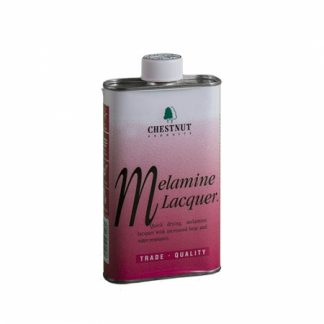
 When you’re looking for a hard-wearing, heat and water resistant, quick drying gloss lacquer you need look no further than Melamine Lacquer.
Based on cellulose technology, Melamine Lacquer has a catalyst suspended within it; when the lacquer is in the can it is inert but once applied and exposed to the air, the lacquer dries within five minutes like a cellulose and then the catalyst kicks in and the lacquer goes on to chemically cure to give a more durable coating. 90% of the curing process happens in the first seven days after application, making the lacquer very hard wearing, the remaining 10% of the process can take up to two weeks more to give maximum toughness, something you only need to consider if the lacquer is going to be subjected to extremely hard use.
Melamine Lacquer is designed to give a full gloss finish which will be achieved with a very careful application. It can be applied by brush (foam or bristle), cloth or by spraying. Where necessary, use cellulose thinners to dilute the product – especially helpful if working on a large area.
The gloss level of Melamine Lacquer can be increased by using burnishing cream once it has dried, and it can also be overcoated with friction polish (to increase the depth of the shine) or woodwax 22 or microcrystalline wax (for a more natural feel).
When you’re looking for a hard-wearing, heat and water resistant, quick drying gloss lacquer you need look no further than Melamine Lacquer.
Based on cellulose technology, Melamine Lacquer has a catalyst suspended within it; when the lacquer is in the can it is inert but once applied and exposed to the air, the lacquer dries within five minutes like a cellulose and then the catalyst kicks in and the lacquer goes on to chemically cure to give a more durable coating. 90% of the curing process happens in the first seven days after application, making the lacquer very hard wearing, the remaining 10% of the process can take up to two weeks more to give maximum toughness, something you only need to consider if the lacquer is going to be subjected to extremely hard use.
Melamine Lacquer is designed to give a full gloss finish which will be achieved with a very careful application. It can be applied by brush (foam or bristle), cloth or by spraying. Where necessary, use cellulose thinners to dilute the product – especially helpful if working on a large area.
The gloss level of Melamine Lacquer can be increased by using burnishing cream once it has dried, and it can also be overcoated with friction polish (to increase the depth of the shine) or woodwax 22 or microcrystalline wax (for a more natural feel).

-
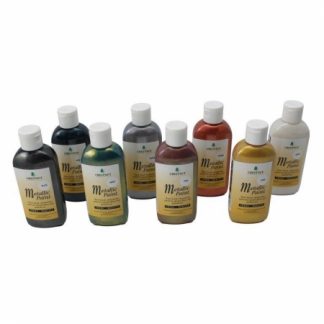 This exciting range of water-based acrylic paints comes in 8 metallic colours. Designed to add an even shimmer to your work they will really make it glow. Mix and match them, use them to highlight certain areas or cover everything in them, the choice is yours. Best used over sanding sealers, apply a spray lacquer over them once dry to seal them in. Can be applied by cloth, brush, spray gun, air brush or any suitable medium you choose!
This exciting range of water-based acrylic paints comes in 8 metallic colours. Designed to add an even shimmer to your work they will really make it glow. Mix and match them, use them to highlight certain areas or cover everything in them, the choice is yours. Best used over sanding sealers, apply a spray lacquer over them once dry to seal them in. Can be applied by cloth, brush, spray gun, air brush or any suitable medium you choose! -

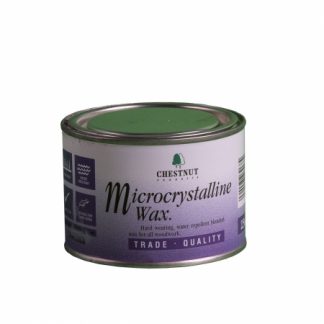
 Chestnut Products’ Microcrystalline Wax is a blend of high quality waxes rich in microcrystalline wax – a wax derived from the petroleum refining process and known for the fineness of its crystals.
This is mixed with a special solvent to create a firm wax which, when dry, knits down to form a very dense coating making it very water resistant, meaning that it is ideal for any items that are likely to come into contact with water for short periods of time.
Microcrystalline waxes also have a higher melting point than other waxes traditionally used to make polishing waxes, the benefit of which is that repeated handling of items finished in Microcrystalline Wax won’t finger mark in the same way, as the melting point is higher than normal body temperature.
Microcrystalline Wax should be used over one of the Chestnut Products’ sanding sealers and allowed to dry (about 20 minutes) before buffing to a shine.
For best results apply a very thin coat, spreading the wax evenly over the entire surface.
Microcrystalline Wax can also be used on the buffing wheel system. In this situation use the A and B Wheel as normal, then apply the Microcrystalline Wax to the item you are polishing. Allow 20 minutes for the wax to dry then buff and normal using the C Wheel. You can use the same C Wheel for both Microcrystalline Wax and the Carnuaba Wax Stick.
Microcrystalline Wax has been tested to the EN71 Part 3 regulations regarding coatings used on toys.
Chestnut Products’ Microcrystalline Wax is a blend of high quality waxes rich in microcrystalline wax – a wax derived from the petroleum refining process and known for the fineness of its crystals.
This is mixed with a special solvent to create a firm wax which, when dry, knits down to form a very dense coating making it very water resistant, meaning that it is ideal for any items that are likely to come into contact with water for short periods of time.
Microcrystalline waxes also have a higher melting point than other waxes traditionally used to make polishing waxes, the benefit of which is that repeated handling of items finished in Microcrystalline Wax won’t finger mark in the same way, as the melting point is higher than normal body temperature.
Microcrystalline Wax should be used over one of the Chestnut Products’ sanding sealers and allowed to dry (about 20 minutes) before buffing to a shine.
For best results apply a very thin coat, spreading the wax evenly over the entire surface.
Microcrystalline Wax can also be used on the buffing wheel system. In this situation use the A and B Wheel as normal, then apply the Microcrystalline Wax to the item you are polishing. Allow 20 minutes for the wax to dry then buff and normal using the C Wheel. You can use the same C Wheel for both Microcrystalline Wax and the Carnuaba Wax Stick.
Microcrystalline Wax has been tested to the EN71 Part 3 regulations regarding coatings used on toys.

-
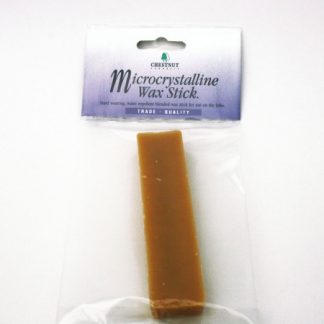
 This is the same wax Chestnut use in the tinned version of Microcrystalline Wax but in a solid block form with no solvent. This means there’s no waiting around for it to dry before buffing it.
Like the original version, this wax should be used very sparingly, a little goes a very long way and once applied it might even be necessary to spread it thinner using Safety Cloth (the texture of this makes it ideal for this purpose).
The Microcrystalline Wax Stick is also perfect for use on the Buffing Wheel System, use it on Wheel C to buff up to a brilliant, hard wearing finish.
This is the same wax Chestnut use in the tinned version of Microcrystalline Wax but in a solid block form with no solvent. This means there’s no waiting around for it to dry before buffing it.
Like the original version, this wax should be used very sparingly, a little goes a very long way and once applied it might even be necessary to spread it thinner using Safety Cloth (the texture of this makes it ideal for this purpose).
The Microcrystalline Wax Stick is also perfect for use on the Buffing Wheel System, use it on Wheel C to buff up to a brilliant, hard wearing finish. -
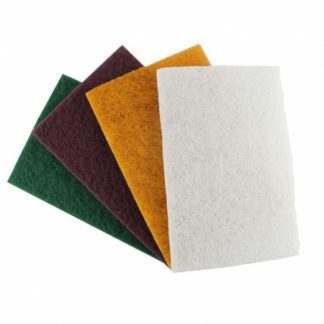 NyWeb pads are a non-woven nylon webbing with an abrasive – either silicon carbide or aluminium oxide – embedded into them to give an exactly defined cut.
NyWeb pads are a non-woven nylon webbing with an abrasive – either silicon carbide or aluminium oxide – embedded into them to give an exactly defined cut.- The Green pads are 400 grit
- The Red pads are 600 grit
- The Orange pads are 1000 grit
- The White pads do not contain an abrasive and are thus technically non-abrasive, but the very texture of the pads gives them an incredibly fine – but immeasurable – cut.
-
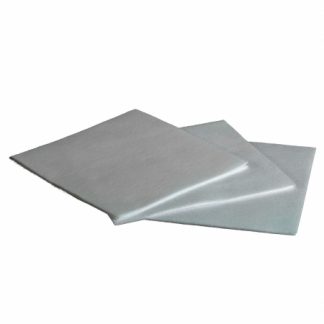 Safety Cloth is a thick, non-woven paper cloth. Designed to stay wet longer to assist the transfer of finishes to your chosen surface, it also tears very easily if it gets caught in revolving parts thus avoiding the danger of fingers being dragged into machinery. The texture of Safety Cloth ensures that a thin, even coat is applied and the thickness means that it retains it’s strength and the same piece can be used several times with the same finish. Safety Cloth is not a replacement for common sense and good safety practise.
Safety Cloth is a thick, non-woven paper cloth. Designed to stay wet longer to assist the transfer of finishes to your chosen surface, it also tears very easily if it gets caught in revolving parts thus avoiding the danger of fingers being dragged into machinery. The texture of Safety Cloth ensures that a thin, even coat is applied and the thickness means that it retains it’s strength and the same piece can be used several times with the same finish. Safety Cloth is not a replacement for common sense and good safety practise. -

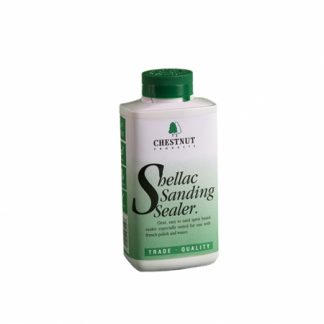
 Shellac Sanding Sealer is the traditional way of sealing timber prior to applying a polish or a wax.
Chestnuts version has a high percentage of real shellac which means it does the job extremely well, dissolved in an ethanol solution to make it easy to apply and quick drying.
Applied by cloth, brush or spray it dries in about 20 minutes, making it very popular for cabinet and architectural work as it is easy to keep a wet edge running. It is also popular with woodturners and highlights the natural grain of the timber extremely well.
Sand back lightly after application and apply Friction Polish, French Polish or any of Chestnuts waxes on top.
Conforms to EN71 Part 3 – suitable for toys and nursery furniture.
Shellac Sanding Sealer is the traditional way of sealing timber prior to applying a polish or a wax.
Chestnuts version has a high percentage of real shellac which means it does the job extremely well, dissolved in an ethanol solution to make it easy to apply and quick drying.
Applied by cloth, brush or spray it dries in about 20 minutes, making it very popular for cabinet and architectural work as it is easy to keep a wet edge running. It is also popular with woodturners and highlights the natural grain of the timber extremely well.
Sand back lightly after application and apply Friction Polish, French Polish or any of Chestnuts waxes on top.
Conforms to EN71 Part 3 – suitable for toys and nursery furniture.

-

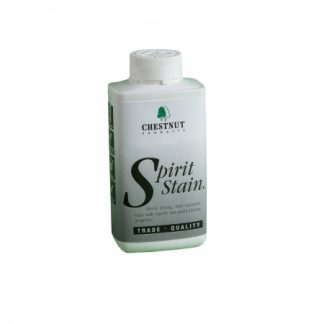 An exciting and vibrant set of colours for staining wood, Spirit Stains are methanol based to make them quick drying and because of this they also will not raise the grain of the timber they are applied to. The pigments used to make this stains are of the highest quality and all score the top ratings of 7s and 8s in the Blue Wool Scale, the measuring system used to rate fade resistance. This means you can use them with confidence knowing that the colour you apply will still be the same many years later. Spirit Stains are fully inter-mixable so you can produce virtually any colour you can think of, giving you full opportunity to be as creative as you wish. The colours will also mix after application so you can blend from one colour to another for fantastic ‘flare’ effects. Spirit Stain White is designed primarily as a mixer to create pastel shades when mixed with other Spirit Stain colours. It can be used to stain timber but as it is a translucent stain this can have a limited effect depending on the base colour of the timber used. Should you want a more subtle colour you can dilute the stains with Spirit Thinners for a delicate wash effect.
An exciting and vibrant set of colours for staining wood, Spirit Stains are methanol based to make them quick drying and because of this they also will not raise the grain of the timber they are applied to. The pigments used to make this stains are of the highest quality and all score the top ratings of 7s and 8s in the Blue Wool Scale, the measuring system used to rate fade resistance. This means you can use them with confidence knowing that the colour you apply will still be the same many years later. Spirit Stains are fully inter-mixable so you can produce virtually any colour you can think of, giving you full opportunity to be as creative as you wish. The colours will also mix after application so you can blend from one colour to another for fantastic ‘flare’ effects. Spirit Stain White is designed primarily as a mixer to create pastel shades when mixed with other Spirit Stain colours. It can be used to stain timber but as it is a translucent stain this can have a limited effect depending on the base colour of the timber used. Should you want a more subtle colour you can dilute the stains with Spirit Thinners for a delicate wash effect.
-

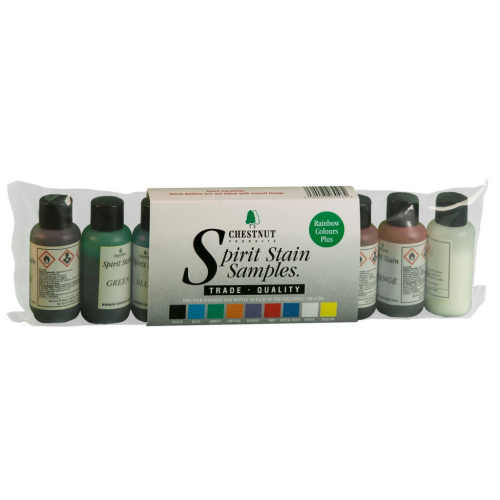
The ideal way to experiment with the different colours available to decide which ones you prefer, the Spirit Stain Kit contains one bottle (min. contents 25ml) of each of the nine colours. These are exactly the same stain as in the bigger bottles and will intermix if you want to vary the shades available.
The stains are very fade resistant, quick drying and non-grain raising.
-
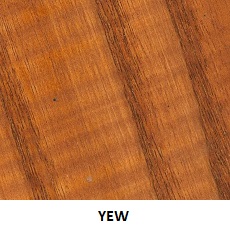
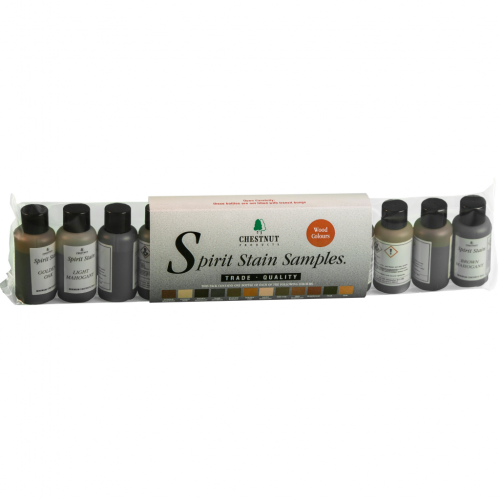 The ideal way to experiment with the different colours available to decide which ones you prefer, the Spirit Stain Kit contains one bottle (min. contents 25ml) of each of the twelve wood colours. These are exactly the same stain as in the bigger bottles and will intermix if you want to vary the shades available. The stains are very fade resistant, quick drying and non-grain raising.
The ideal way to experiment with the different colours available to decide which ones you prefer, the Spirit Stain Kit contains one bottle (min. contents 25ml) of each of the twelve wood colours. These are exactly the same stain as in the bigger bottles and will intermix if you want to vary the shades available. The stains are very fade resistant, quick drying and non-grain raising.
-

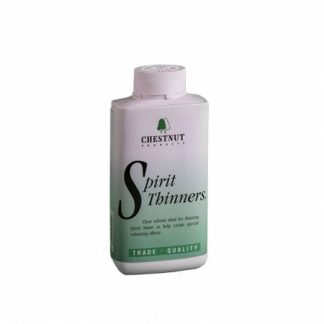 This clear, slower drying solvent is primarily for thinning our Spirit Stain to give delicate wash effects without affecting the colour (as methylated spirit would). It can also be used to dilute Friction Polish or French Polish if needed (usually only when the cap has been left off and the product has thickened up). It’s also suitable for use in making french polish if you want to dissolve shellac flakes in it.
This clear, slower drying solvent is primarily for thinning our Spirit Stain to give delicate wash effects without affecting the colour (as methylated spirit would). It can also be used to dilute Friction Polish or French Polish if needed (usually only when the cap has been left off and the product has thickened up). It’s also suitable for use in making french polish if you want to dissolve shellac flakes in it.
-
Out of stock
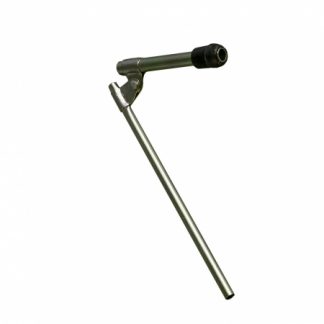 Chestnut Spray Diffusers are ideal for applying Spirit Stain; one end goes in the stain and you blow through the other end for your own mini-spray gun. Great for special decorative effects.
Chestnut Spray Diffusers are ideal for applying Spirit Stain; one end goes in the stain and you blow through the other end for your own mini-spray gun. Great for special decorative effects. -
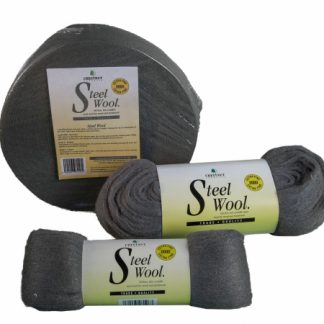 The finest of Steel Wool, very low crumble and virtually oil free to ensure there is no contamination of your work. Use it after sanding with abrasive sheets to give an ultra smooth surface, or to apply waxes to smooth the timber whilst applying a thin coat. Steel Wool burns very quickly and easily; keep it away from sources of combustion (i.e. sparks etc). Always use a knife or scissors to cut Steel Wool
The finest of Steel Wool, very low crumble and virtually oil free to ensure there is no contamination of your work. Use it after sanding with abrasive sheets to give an ultra smooth surface, or to apply waxes to smooth the timber whilst applying a thin coat. Steel Wool burns very quickly and easily; keep it away from sources of combustion (i.e. sparks etc). Always use a knife or scissors to cut Steel Wool -
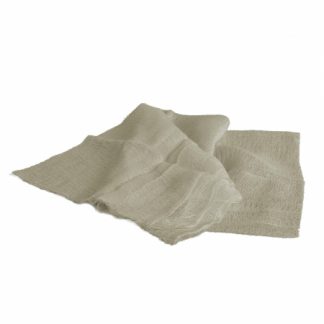 Tack Cloths are coated with a special, sticky resin. The resin doesn’t transfer off the cloth but when you wipe it across a surface it picks up and dust and removes it, leaving behind a clean surface ready for finishing. This makes it ideal for use after your final sanding to make sure that all of the sawdust generated is removed and doesn’t affect your finishing. Tack Cloths are supplied in a sealed wrapper; once opened store them in an air-tight container to prevent them from drying out. Do not use Tack Cloth with the lathe running.
Tack Cloths are coated with a special, sticky resin. The resin doesn’t transfer off the cloth but when you wipe it across a surface it picks up and dust and removes it, leaving behind a clean surface ready for finishing. This makes it ideal for use after your final sanding to make sure that all of the sawdust generated is removed and doesn’t affect your finishing. Tack Cloths are supplied in a sealed wrapper; once opened store them in an air-tight container to prevent them from drying out. Do not use Tack Cloth with the lathe running.

